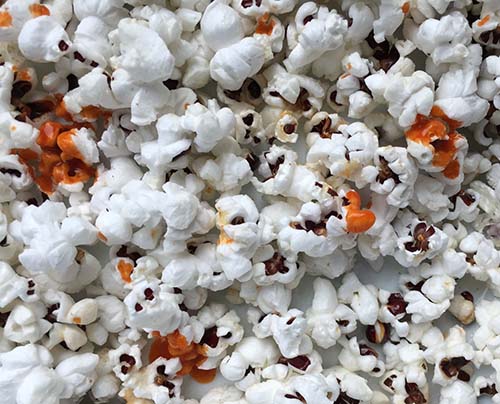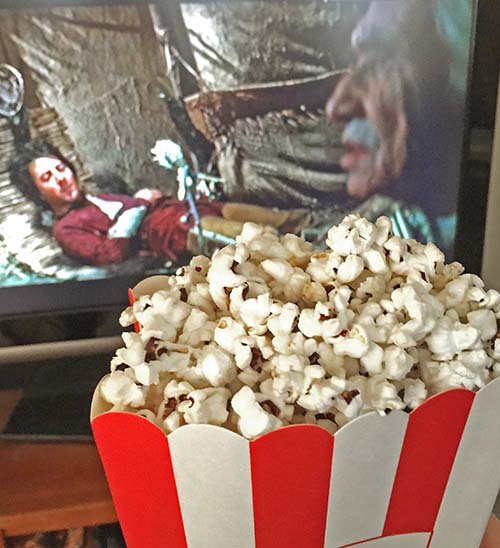 [I] have complete respect for the days set aside to honor, including Jan. 19, which is also National Popcorn Day. That being said, it occurs to me there is no day set aside to honor the First Americans.
[I] have complete respect for the days set aside to honor, including Jan. 19, which is also National Popcorn Day. That being said, it occurs to me there is no day set aside to honor the First Americans.
Some of us choose not to forget. In so doing, I honor not only a day of popcorn, but the first movie I remember seeing. It is still just about my favorite.
Since it was “Little Big Man,†how could it not be?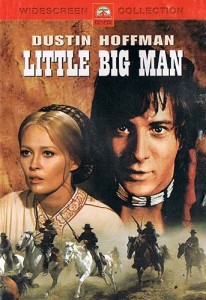 1970, I was but a wee lass, not yet in school, but absorbing all I saw. A night out at the movies — the drive-in — was not only the biggest adventure of my life at that time, but the launching of my lifelong love of movies. I’m not sure what I got out of “Little Big Man†at that young age, but it was unforgettable and profound enough that I continue to watch it every year — at least once.
1970, I was but a wee lass, not yet in school, but absorbing all I saw. A night out at the movies — the drive-in — was not only the biggest adventure of my life at that time, but the launching of my lifelong love of movies. I’m not sure what I got out of “Little Big Man†at that young age, but it was unforgettable and profound enough that I continue to watch it every year — at least once.
At the dawn of the ‘70s, the world of movies was changing. With Little Big Man came a “revisionist†western that turned the previous notion of Indians as villains and the white man as hero on its ear. Arthur Penn’s masterpiece (based on the 1964 novel by Thomas Berger
) looks over the life of 121-year-old Jack Crabb (played by Dustin Hoffman)who claims to be the lone white survivor of the Battle of the Little Big Horn. This tale weaves one man’s life (ala “Forrest Gump†before Forrest was even a thought) into a changing American history, as Crabb lives among both American Indians and the whites who are betraying and destroying them. As with Gump, Crabb embodies many lifetimes in one as he becomes an American Indian warrior, U.S. Army scout, gunslinger, snake oil salesman, mercantile owner and drunk. Throughout his adventures, he finds himself at significant historical junctures, running into such icons of the 19th century as Wild Bill Hickock and General George Armstrong Custer
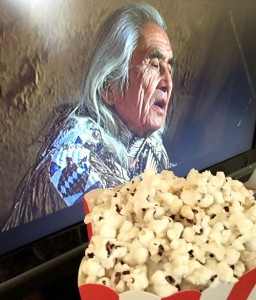 As a boy, Crabb is raised by the Cheyenne (who call themselves “human beingsâ€), specifically under the tutelage of Old Lodge Skins (played by Chief Dan George), who gives the undersized Crabb the name Little Big Man because his bravery is so big. Key moments in the film see Crabb and Lodge Skins together in a teepee, talking, and it is Lodge Skins’ words that resonant most significantly and powerfully throughout this film. In one scene, Crabb asks Lodge Skins if he hates the white man. Lodge Skins holds up a scalp and says: “Do you see this fine thing? Do you admire the humanity of it? Because the human beings, my son, they believe everything is alive. Not only man and animals. But also water, earth, stone. And also the things from them… like that hair. The man from whom this hair came, he’s bald on the other side, because I now own his scalp! That is the way things are. But the white man, they believe EVERYTHING is dead. Stone, earth, animals. And people! Even their own people! If things keep trying to live, white man will rub them out. That is the difference.â€
As a boy, Crabb is raised by the Cheyenne (who call themselves “human beingsâ€), specifically under the tutelage of Old Lodge Skins (played by Chief Dan George), who gives the undersized Crabb the name Little Big Man because his bravery is so big. Key moments in the film see Crabb and Lodge Skins together in a teepee, talking, and it is Lodge Skins’ words that resonant most significantly and powerfully throughout this film. In one scene, Crabb asks Lodge Skins if he hates the white man. Lodge Skins holds up a scalp and says: “Do you see this fine thing? Do you admire the humanity of it? Because the human beings, my son, they believe everything is alive. Not only man and animals. But also water, earth, stone. And also the things from them… like that hair. The man from whom this hair came, he’s bald on the other side, because I now own his scalp! That is the way things are. But the white man, they believe EVERYTHING is dead. Stone, earth, animals. And people! Even their own people! If things keep trying to live, white man will rub them out. That is the difference.â€
Added to the Library of Crongress’s National Film Registry in 2014,
“Little Big Manâ€â€˜s messages could have been schmaltzy, heavy-handed and less effective, but that fact that it was satire cured that. There is a lot of funny in this film, from Crabb’s attempts to be a legendary gunfighter to his interactions with such hilariously rendered characters as Faye Dunaway’s fallen minister’s wife to Martin Balsam’s limb-deficient barker of a medicine show to Richard Mulligan’s unsettlingly humourous portrayal of a batty Custer.
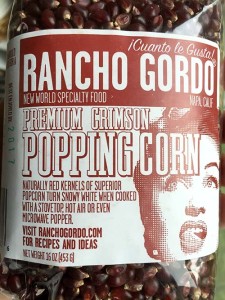 But the film is also heartbreakingly devastating. I end each time watching moved beyond belief. I love this story, yet, futilely, want the basis for it to have been different.
But the film is also heartbreakingly devastating. I end each time watching moved beyond belief. I love this story, yet, futilely, want the basis for it to have been different.
When I saw “Little Big Man†in 1970, it was likely in the backseat of my parent’s car, with handfuls of greasy popcorn crunching into my mouth. Things don’t really change in that camp.
Except, I ran across a different kind of corn recently at the San Francisco Ferry Building and decided to give it a try. Rancho Gordo’s Crimson Red Premium Popping Corn has been written up aplenty as a favorite among foodies, and having tried it, I understand.
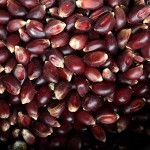
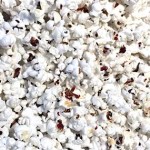 It’s a beautiful corn — hull-less, which is a bonus — that pops up to an almost eerie glowing white. As I mentioned in my previous popcorn blog entry (10/14), I always pop my corn stovetop, using a 10-inch by 3-inch deep saute pan. The large pan diameter gives the corn an even layer upon which to heat.
It’s a beautiful corn — hull-less, which is a bonus — that pops up to an almost eerie glowing white. As I mentioned in my previous popcorn blog entry (10/14), I always pop my corn stovetop, using a 10-inch by 3-inch deep saute pan. The large pan diameter gives the corn an even layer upon which to heat.
I recommend your basic canola oil for cooking, although I have mixed in olive oil on occasion and plan to try coconut oil soon. Keep the heat between medium and high; run a “test kernel†to see if the pan is 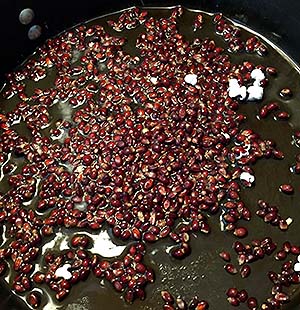 hot enough to pop. Pour in your corn and one trick I use is, sprinkle a little popcorn salt over the un-popped kernels as they begin to sizzle, so your corn is salted when it comes out of the pan. Make sure your pan is tightly covered. Once the kernels begin to pop, keep shaking (one burned kernel will ruin the whole pot). Do not stop periodic shaking until you hear the popping begin to slow, then turn off the heat.
hot enough to pop. Pour in your corn and one trick I use is, sprinkle a little popcorn salt over the un-popped kernels as they begin to sizzle, so your corn is salted when it comes out of the pan. Make sure your pan is tightly covered. Once the kernels begin to pop, keep shaking (one burned kernel will ruin the whole pot). Do not stop periodic shaking until you hear the popping begin to slow, then turn off the heat.
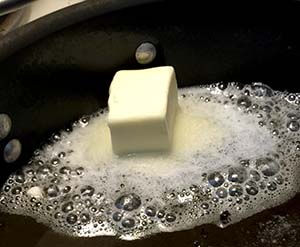 Dump your popcorn in a bowl. You can stop there (if you salted), or embellish. Being who I am, I throw a little butter into the still-hot pan and add to the corn. Recently, I took it a step further with some buffalo wing sauce to add a kick, here or there, to the snow-white corn. This corn is smaller-kerneled but with a deep, dusky, earthy taste (little corn, big flavor). And leaves you less apt to pick your teeth for days afterward.
Dump your popcorn in a bowl. You can stop there (if you salted), or embellish. Being who I am, I throw a little butter into the still-hot pan and add to the corn. Recently, I took it a step further with some buffalo wing sauce to add a kick, here or there, to the snow-white corn. This corn is smaller-kerneled but with a deep, dusky, earthy taste (little corn, big flavor). And leaves you less apt to pick your teeth for days afterward.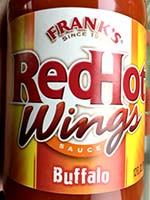
If you have never seen “Little Big Man,†see it. If it’s been a while, see it again. Good corn and a great movie. A great movie moves you to a certain kind of understanding (Lodge Skins: “…there will always be an endless supply of white men, but a limited number of human beings.â€) A message… that we will not forget, as Crabb says, “as long as grass grows and wind blows, and the sky is blue.â€